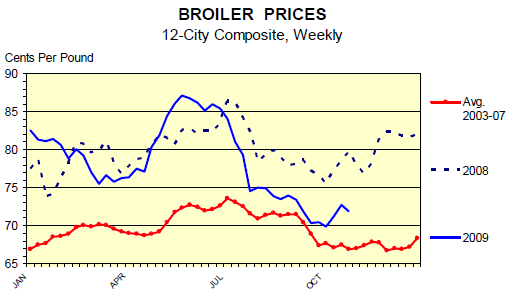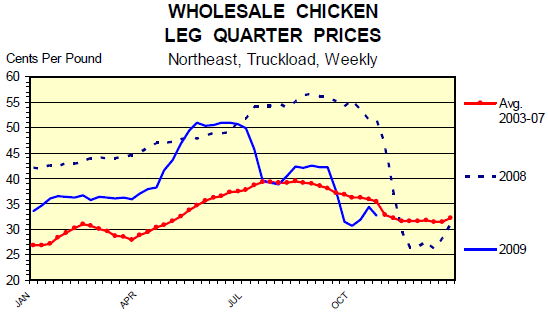



CME: Chicken Demand Lower Than a Year Ago
US - Consumer-level demand for pork remained strong through September, according to the University of Missouri, report Steve Meyer and Len Steiner.The index of pork demand gained 0.1 per cent relative to last year and stood 4 per cent higher at the end of February. The higher index means that retail prices have not had to be lowered as much as expected to move the larger quantities of pork that have been placed on the US market since the novel H1N1 influenza situation began in late April. In fact, monthly domestic pork disappearance in June, July and August 2009 were all among the top three in history for the respective month.

Beef demand continued in a difficult year, falling 0.3 per cent farther behing last year’s level. The beef demand index now stands 2.3 per cent lower than last year. Should it end the year at this level, the index will be at its lowest level since 1999.
Chicken demand remained lower than one year ago at – 2.9 per cent but gained 0.5 per cent on last year’s level in September. Chicken demand has improved relative to last year every month so far in 2009 but it began the year at such an abysmal level (-6.3 per cent as of April) that it had little place to go but up. The chicken situation was just the opposite of that faced by pork as retail chicken prices could not be improved enough even with unprecedented reductions in quantity supplied. And chicken prices are still nothing to shout about — as can be seen in the chart.

The biggest culprits relative to 2008 have been legs and leg quarters. Both of those got an apparent windfall in May and June, presumably as substitutes for pork in either domestic or export markets or both. But the surge of leg quarter prices from just under $0.40/lb. to over $0.50/lb lasted only until the end of June and prices have now plummeted to their lowest level ($32.71/cwt last week) since late last year. The leg quarter price pattern is reflected nearly perfectly in the composite price graph.

The good news about breast meat prices is that they have stayed very close to 2008 levels almost all of 2009. Of course, the bad news for breast prices is the same — they have stayed close to the levels of 2008 which were anywhere from $0.15 to $0.30/lb. lower than the average for the previous 5 years.

A healthy portion of the breast meat problem can be attributed to the softness of US foodservice demand since last year but supply played a factor as well. Dr. Paul Aho, noted poultry economist and president of Poultry Perspectives, Storrs, CT, points out that broiler breast meat yields have risen from roughly 15 per cent of live body weight in 1985 to over 22 per cent of live weight in 2009. Add even more weight for the basting (or pumping) done to most chicken breasts and one can see that supply is putting downward pressure on breast prices as well.
And that brings us to wings, the former dead-weight and now star of the chicken value show! Wing prices have exceeded boneless, skinless breast prices for almost all of 2009 and reached a record high nearly $1.67 per pound in mid-October. They are now both a large contributor and consistent contributor to chicken value. While US consumers have apparently passed on chicken breast sandwiches and thick steaks, it appears that a basket of wings and a beer for under $10 is still a great deal. How will that play out as the recession wanes?









